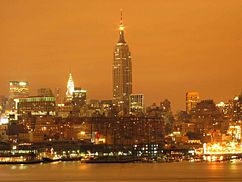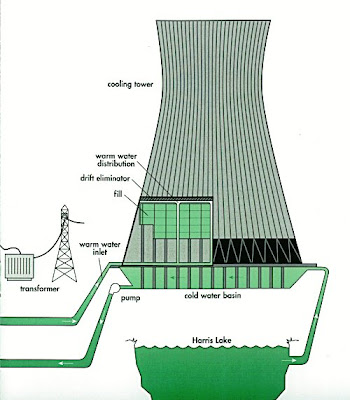Light Pollution
Light pollution, also known as photopollution or luminous pollution, is excessive or obtrusive artificial light. Light pollution is defined as:
It obscures the stars in the night sky for city dwellers, interferes with astronomical observatories, and, like any other form of pollution, disrupts ecosystems and has adverse health effects. Light pollution can be divided into two main types: 1) annoying light that intrudes on an otherwise natural or low-light setting and 2) excessive light (generally indoors) that leads to discomfort and adverse health effects. Since the early 1980s, a global dark-sky movement has emerged, with concerned people campaigning to reduce the amount of light pollution.
Light pollution
Light pollution is a side effect of industrial civilization. Its sources include building exterior and interior lighting, advertising, commercial properties, offices, factories, streetlights, and illuminated sporting venues. It is most severe in highly industrialized, densely populated areas of North America, Europe, and Japan and in major cities in the Middle East and North Africa like Cairo, but even relatively small amounts of light can be noticed and create problems. Like other forms of pollution (such as air, water, and noise pollution) light pollution causes damage to the environment.
Impact on Energy Usage
Energy conservation advocates contend that light pollution must be addressed by changing the
habits of society, so that lighting is used more
efficiently, with less waste and less creation of unwanted or unneeded illumination. The case against light pollution is strengthened by a range of studies on health effects, suggesting that excess light may induce loss in
visual acuity,
hypertension,
headaches and increased incidence of
carcinoma. Several industry groups also recognize light pollution as an important issue.

one form of light pollution.
Information about light pollution, the problems it causes, and how to reduce its impact.
Since not everyone is irritated by the same lighting sources, it is common for one person's light "pollution" to be light that is desirable for another. One example of this is found in advertising, when an advertiser wishes for particular lights to be bright and visible, even though others find them annoying. Other types of light pollution are more certain. For instance, light that accidentally crosses a property boundary and annoys a neighbor is generally wasted and pollutive light.
Types
Light pollution is a broad term that refers to multiple problems, all of which are caused by inefficient, unappealing, or (arguably) unnecessary use of artificial light. Specific categories of light pollution include
light trespass,
over-illumination,
light clutter, and
sky glow.
Light trespass
Light trespass occurs when unwanted light enters one's property, for instance, by shining over a neighbor's fence. A common light trespass problem occurs when a strong light enters the window of one's home from the outside, causing problems such as sleep deprivation or the blocking of an evening view.
Over-illumination
Over-illumination is the excessive use of light.Office building illuminated by
high pressure sodium (HPS) lamps shining upward, of which much light goes into the sky and neighboring apartment blocks and causes light pollution

Over-illumination stems from several factors:
- Not using timers, occupancy sensors or other controls to extinguish lighting when not needed
- Improper design, especially of workplace spaces, by specifying higher levels of light than needed for a given task
- Incorrect choice of fixtures or light bulbs, which do not direct light into areas as needed
- Improper selection of hardware to utilize more energy than needed to accomplish the lighting task
- Incomplete training of building managers and occupants to use lighting systems efficiently
- Inadequate lighting maintenance resulting in increased stray light and energy costs
- "Daylight lighting" can be required by citizens to reduce crime or by shop owners to attract customers, so over-illumination can be a design choice, not a fault. In both cases target achievement is questionable.
- Substitution of old mercury lamps with more efficient sodium or metal halide lamps using the same electrical power
- Indirect lighting techniques, such as lighting a vertical wall to bounce photons on the ground.
Light clutter

Las Vegas displays excessive groupings of colorful lights. This is a classic example of light clutter.
Light clutter refers to excessive groupings of lights. Groupings of lights may generate confusion, distract from obstacles (including those that they may be intended to illuminate), and potentially cause accidents. Clutter is particularly noticeable on roads where the street lights are badly designed, or where brightly lit advertising surrounds the roadways. Depending on the motives of the person or organization who installed the lights, their placement and design may even be intended to distract drivers, and can contribute to accidents.
Skyglow
Skyglow refers to the "glow" effect that can be seen over populated areas. It is the combination of all light reflected from what it has illuminated escaping up into the sky and from all of the badly directed light in that area that also escapes into the sky, being scattered by the atmosphere back toward the ground. This scattering is very strongly related to the wavelength of the light when the air is very clear (with very little aerosols). Rayleigh scattering dominates in such clear air, making the sky appear blue in the daytime. When there is significant aerosol (typical of most modern polluted conditions), the scattered light has less dependence on wavelength, making a whiter daytime sky. Because of this Rayleigh effect, and because of the eye's increased sensitivity to white or blue-rich light sources when adapted to very low light levels, white or blue-rich light contributes significantly more to sky-glow than an equal amount of yellow light. Sky glow is of particular irritation to astronomers, because it reduces contrast in the night sky to the extent where it may even become impossible to see any but the brightest stars.
Measurement and Global Effects

False colors show various intensities of radiation — both direct and indirect — from artificial light sources that reach space (Image credit: P. Cinzano)
Measuring the effect of sky glow on a global scale is a complex procedure. The natural atmosphere is not completely dark, even in the absence of terrestrial sources of light. This is caused by two main sources: airglow and scattered light.
At high altitudes, primarily above the mesosphere, UV radiation from the sun is so intense that ionization occurs. When these ions collide with electrically neutral particles they recombine and emit photons in the process, causing airglow. The degree of ionization is sufficiently large to allow a constant emission of radiation even during the night when the upper atmosphere is in the Earth's shadow.
Apart from emitting light, the sky also scatters incoming light, primarily from distant stars and the Milky Way, but also sunlight that is reflected and backscattered from interplanetary dust particles (the so-called Zodiacal light).
Consequences
Energy waste
Lighting is responsible for one-fourth of all energy consumption worldwide and case studies have shown that several forms of over-illumination constitute energy wastage, including non-beneficial upward direction of night-time lighting. In 2007, a saving of 645.2 million kWh in electricity consumption during the daylight saving period from April to October report comes out. It attributes this saving to the delayed need for artificial lighting during the evenings.
Effects on human health and psychology
Medical research on the effects of excessive light on the human body suggests that a variety of adverse health effects may be caused by light pollution or excessive light exposure, and some lighting design textbooks use human health as an explicit criterion for proper interior lighting. Health effects of over-illumination or improper spectral composition of light may include: increased headache incidence, worker fatigue, medically defined stress, decrease in sexual function and increase in anxiety.
Common levels of fluorescent lighting in offices are sufficient to elevate blood pressure by about eight points. There is some evidence that lengthy daily exposure to moderately high lighting leads to diminished sexual performance. Specifically within the USA, there is evidence that levels of light in most office environments lead to increased stress as well as increased worker errors.
Disruption of ecosystems
Light pollution poses a serious threat to wildlife, having negative impacts on plant and animal physiology. Light pollution can confuse animal navigation, alter competitive interactions, change predator-prey relations, and cause physiological harm.The rhthym of life is orchestrated by the natural diurnal patterns of light and dark, so disruption to these patterns impacts the ecolgical dynamics.
Migrating birds can be disoriented by lights on tall structures.
Night blooming flowers that depend on moths for pollination may be affected by night lighting, as there is no replacement pollinator that would not be affected by the artificial light.
Effect on astronomy

The constellation Orion, imaged at left from dark skies, and at right from within the Provo/Orem, Utah metropolitan area.
Skyglow reduces the contrast between stars and galaxies in the sky and the sky itself, making it more difficult to detect fainter objects. This is one factor that has caused newer telescopes to be built in increasingly remote areas. Some astronomers use narrow-band "nebula filters" which only allow specific wavelengths of light commonly seen in nebulae, or broad-band "light pollution filters" which are designed to reduce the effects of light pollution by filtering out spectral lines commonly emitted by sodium- and mercury-vapor lamps, thus enhancing contrast and improving the view of dim objects such as galaxies and nebulae. Unfortunately this affects color perception, so these filters cannot be used to visually estimate variable star brightness, and no filter can match the effectiveness of a dark sky for visual or photographic purposes. Due to low surface brightness, the visibility of diffuse sky objects such as nebulae and galaxies is affected by light pollution more than are stars. A simple method for estimating the darkness of a location is to look for the Milky Way.
Reduction

This kind of LED droplight could reduce unnecessary light pollution in building interiors
Reducing light pollution implies many things, such as reducing sky glow, reducing glare, reducing light trespass, and reducing clutter. The method for best reducing light pollution, therefore, depends on exactly what the problem is in any given instance. Possible solutions include:
- Utilizing light sources of minimum intensity necessary to accomplish the light's purpose.
- Turning lights off using a timer or occupancy sensor or manually when not needed.
- Improving lighting fixtures, so that they direct their light more accurately towards where it is needed, and with less side effects.
- Adjusting the type of lights used, so that the light waves emitted are those that are less likely to cause severe light pollution problems.
- Evaluating existing lighting plans, and re-designing some or all of the plans depending on whether existing light is actually needed.
- some or all of the plans depending on whether existing light is actually needed.
Adjusting types of light sources
Several different types of light sources exist, each having different properties that affect their appropriateness for certain tasks, particularly efficiency and spectral power distribution. It is often the case that inappropriate light sources have been selected for a task, either due to ignorance or because more sophisticated light sources were unavailable at the time of installation. Therefore, badly chosen light sources often contribute unnecessarily to light pollution and energy waste. By re-assessing and changing the light sources used, it is often possible to reduce energy use and pollutive effects while simultaneously greatly improving efficiency and visibility.
Some types of light sources, in order of energy efficiency, are:
 But the growth in the intake rate has slowed since the 1980s.
But the growth in the intake rate has slowed since the 1980s.








































